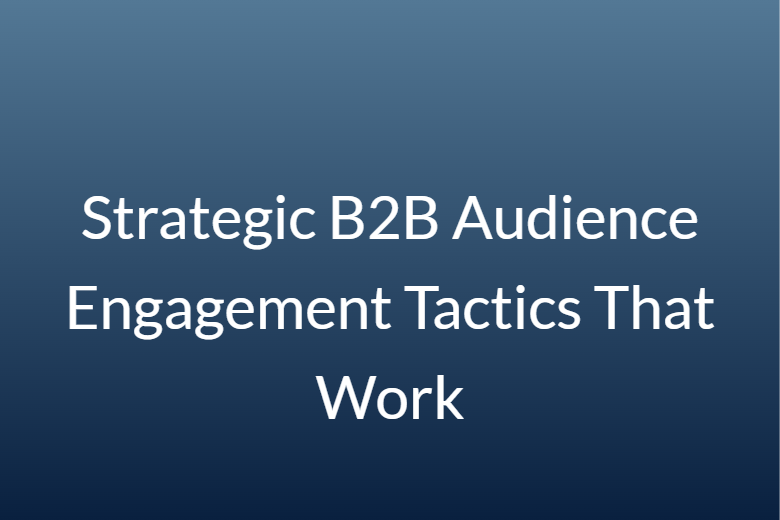Engaging today’s B2B audience requires more than a content calendar and automated emails. It demands precision, personalization, and relevance at every touchpoint. As buyer expectations grow more sophisticated, companies must elevate their B2B Audience Engagement strategies to create value-driven experiences that build trust and drive long-term ROI.
In this blog, we’ll explore advanced, high-impact tactics that define effective B2B audience engagement in the current landscape—where attention is short, competition is fierce, and relationships drive revenue.
1. Use Content Intelligence to Tailor Messaging
Gone are the days of static content strategies. Today, content intelligence tools allow marketers to track audience behavior in real-time—identifying what topics they’re consuming, which formats they prefer, and what journey stage they’re at.
By aligning your editorial calendar with these insights, you can deliver more meaningful, relevant content that resonates with your audience’s needs and goals. This approach supercharges B2B audience engagement by transforming generic messaging into personalized, contextual value.
Strategy Tip: Use AI-powered content recommendation engines to dynamically serve next-step content based on user behavior.
2. Implement Buyer Journey Mapping to Create Value at Every Stage
Effective engagement requires empathy—and that begins with mapping the full buyer journey. Break it down into clear stages: awareness, consideration, evaluation, and decision. Each phase should have distinct goals, content, and engagement strategies.
When your engagement aligns with buyer psychology, you can guide users through the funnel with precision—offering the right resource at the right time.
Strategy Tip: Use journey mapping workshops with your sales and marketing teams to uncover pain points and create matching engagement content.
3. Prioritize Speed and Relevance with Real-Time Personalization
In the age of instant gratification, speed matters. Real-time personalization ensures users get tailored experiences based on their current context—not just historical data.
For example, if a prospect from a SaaS company lands on your site after clicking an ad about AI integrations, your website should dynamically adjust to highlight related case studies, pricing options, and testimonials.
This level of responsiveness builds stronger B2B audience engagement and signals that you understand their specific challenges.
Strategy Tip: Use IP-based firmographic data and cookie tracking to dynamically alter your web content for each visitor segment.
4. Align Marketing and Sales in a Unified Engagement Framework
One of the biggest barriers to effective B2B audience engagement is siloed operations. When sales and marketing operate independently, prospects receive disjointed communication that reduces trust.
A unified engagement strategy ensures consistent messaging across touchpoints—from lead capture to final pitch—and builds credibility throughout the buyer journey.
Strategy Tip: Use shared KPIs and a centralized dashboard to track engagement metrics across both departments.
5. Develop a Layered Content Strategy for Long-Term Engagement
A one-dimensional approach to content won’t cut it. Layer your strategy to include quick-hit content like social posts and snackable videos, mid-funnel content like guides and webinars, and deep-dive content such as eBooks and use cases.
This allows you to engage both first-time visitors and returning prospects—delivering substance at every level of intent.
Strategy Tip: Use pillar content strategies to organize topics by themes, ensuring content depth and discoverability for your B2B audience engagement strategy.
6. Build Trust with Transparent, Humanized Messaging
In B2B, trust is currency. Brands that speak with authenticity—backed by customer proof, third-party validations, and open communication—drive stronger engagement.
Humanized messaging includes featuring real employee voices, behind-the-scenes content, executive viewpoints, and even vulnerability around challenges or lessons learned.
Strategy Tip: Leverage video snippets of your leadership discussing industry trends or customer success stories for maximum relatability.
7. Use Drip Campaigns to Create Micro-Moments of Engagement
Rather than overloading users with lengthy emails or large content bundles, break your communication into digestible, value-driven touchpoints.
Drip campaigns—automated email sequences—allow for structured storytelling. You can start with a problem, offer educational content, then present a solution, gradually moving the user through their journey.
Strategy Tip: Test different narrative styles (storytelling, Q&A, data-driven) within drip campaigns to see which sparks the highest B2B audience engagement.
8. Encourage User-Generated Content and Peer Advocacy
Your best advocates are often your existing users. When prospects hear directly from people in their roles or industries, it adds unmatched credibility.
Encourage customers to share their stories through video testimonials, LinkedIn shoutouts, or even blog co-authoring. Not only does this enhance engagement, but it also boosts visibility and community.
Strategy Tip: Launch a customer spotlight series on social media where users share how your solution transformed their processes.
9. Run Intent-Led Retargeting Campaigns Across Multiple Channels
Retargeting isn’t just for abandoned carts. In B2B, you can run sophisticated retargeting based on a user’s level of engagement, interests, or role.
Intent-led campaigns help re-engage prospects who downloaded a guide, visited a pricing page, or attended a webinar. Personalized retargeting across LinkedIn, programmatic display, or native content can reinforce messaging and accelerate decision-making.
Strategy Tip: Use personalized ad copy and visuals based on the content users previously engaged with to deepen B2B audience engagement.
10. Host Live Discussions to Spark Real-Time Engagement
While pre-recorded content has its place, live interaction offers unmatched immediacy. Hosting live discussions—roundtables, industry Q&As, fireside chats—gives your audience the opportunity to ask questions, share opinions, and connect in real time.
These sessions build community, increase brand visibility, and show that your brand is accessible, current, and tuned into the latest market shifts.
Strategy Tip: Turn your live sessions into on-demand assets and segment viewers by interest level for further nurturing.
Read the Full Blog Now @ https://acceligize.com/featured-blogs/b2b-audience-engagement-best-practices/
About Us
At Acceligize , we specialize in high-impact B2B audience engagement strategies that accelerate lead generation and conversion. Leveraging intent-driven data, AI-powered segmentation, and multi-channel outreach, we connect your brand with the right decision-makers at the perfect time. Our end-to-end demand generation framework empowers marketing teams to drive qualified leads while ensuring each touchpoint delivers measurable results. Partner with us to turn engagement into revenue and build stronger, more meaningful customer relationships in the B2B landscape.
